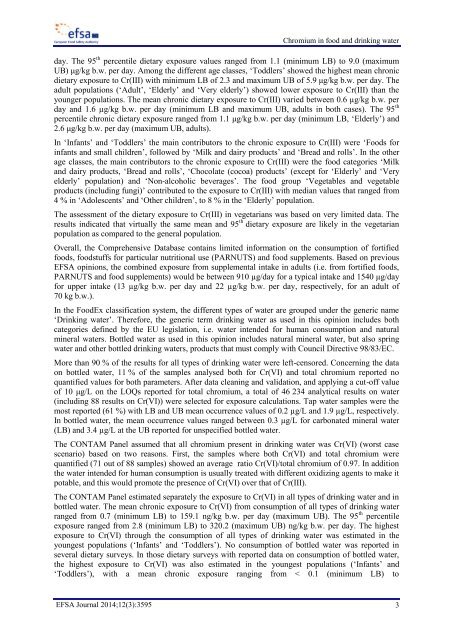efsa-opinion-chromium-food-drinking-water
efsa-opinion-chromium-food-drinking-water
efsa-opinion-chromium-food-drinking-water
Create successful ePaper yourself
Turn your PDF publications into a flip-book with our unique Google optimized e-Paper software.
Chromium in <strong>food</strong> and <strong>drinking</strong> <strong>water</strong><br />
day. The 95 th percentile dietary exposure values ranged from 1.1 (minimum LB) to 9.0 (maximum<br />
UB) μg/kg b.w. per day. Among the different age classes, ‘Toddlers’ showed the highest mean chronic<br />
dietary exposure to Cr(III) with minimum LB of 2.3 and maximum UB of 5.9 μg/kg b.w. per day. The<br />
adult populations (‘Adult’, ‘Elderly’ and ‘Very elderly’) showed lower exposure to Cr(III) than the<br />
younger populations. The mean chronic dietary exposure to Cr(III) varied between 0.6 µg/kg b.w. per<br />
day and 1.6 µg/kg b.w. per day (minimum LB and maximum UB, adults in both cases). The 95 th<br />
percentile chronic dietary exposure ranged from 1.1 μg/kg b.w. per day (minimum LB, ‘Elderly’) and<br />
2.6 μg/kg b.w. per day (maximum UB, adults).<br />
In ‘Infants’ and ‘Toddlers’ the main contributors to the chronic exposure to Cr(III) were ‘Foods for<br />
infants and small children’, followed by ‘Milk and dairy products’ and ‘Bread and rolls’. In the other<br />
age classes, the main contributors to the chronic exposure to Cr(III) were the <strong>food</strong> categories ‘Milk<br />
and dairy products, ‘Bread and rolls’, ‘Chocolate (cocoa) products’ (except for ‘Elderly’ and ‘Very<br />
elderly’ population) and ‘Non-alcoholic beverages’. The <strong>food</strong> group ‘Vegetables and vegetable<br />
products (including fungi)’ contributed to the exposure to Cr(III) with median values that ranged from<br />
4 % in ‘Adolescents’ and ‘Other children’, to 8 % in the ‘Elderly’ population.<br />
The assessment of the dietary exposure to Cr(III) in vegetarians was based on very limited data. The<br />
results indicated that virtually the same mean and 95 th dietary exposure are likely in the vegetarian<br />
population as compared to the general population.<br />
Overall, the Comprehensive Database contains limited information on the consumption of fortified<br />
<strong>food</strong>s, <strong>food</strong>stuffs for particular nutritional use (PARNUTS) and <strong>food</strong> supplements. Based on previous<br />
EFSA <strong>opinion</strong>s, the combined exposure from supplemental intake in adults (i.e. from fortified <strong>food</strong>s,<br />
PARNUTS and <strong>food</strong> supplements) would be between 910 µg/day for a typical intake and 1540 µg/day<br />
for upper intake (13 µg/kg b.w. per day and 22 µg/kg b.w. per day, respectively, for an adult of<br />
70 kg b.w.).<br />
In the FoodEx classification system, the different types of <strong>water</strong> are grouped under the generic name<br />
‘Drinking <strong>water</strong>’. Therefore, the generic term <strong>drinking</strong> <strong>water</strong> as used in this <strong>opinion</strong> includes both<br />
categories defined by the EU legislation, i.e. <strong>water</strong> intended for human consumption and natural<br />
mineral <strong>water</strong>s. Bottled <strong>water</strong> as used in this <strong>opinion</strong> includes natural mineral <strong>water</strong>, but also spring<br />
<strong>water</strong> and other bottled <strong>drinking</strong> <strong>water</strong>s, products that must comply with Council Directive 98/83/EC.<br />
More than 90 % of the results for all types of <strong>drinking</strong> <strong>water</strong> were left-censored. Concerning the data<br />
on bottled <strong>water</strong>, 11 % of the samples analysed both for Cr(VI) and total <strong>chromium</strong> reported no<br />
quantified values for both parameters. After data cleaning and validation, and applying a cut-off value<br />
of 10 μg/L on the LOQs reported for total <strong>chromium</strong>, a total of 46 234 analytical results on <strong>water</strong><br />
(including 88 results on Cr(VI)) were selected for exposure calculations. Tap <strong>water</strong> samples were the<br />
most reported (61 %) with LB and UB mean occurrence values of 0.2 µg/L and 1.9 µg/L, respectively.<br />
In bottled <strong>water</strong>, the mean occurrence values ranged between 0.3 µg/L for carbonated mineral <strong>water</strong><br />
(LB) and 3.4 µg/L at the UB reported for unspecified bottled <strong>water</strong>.<br />
The CONTAM Panel assumed that all <strong>chromium</strong> present in <strong>drinking</strong> <strong>water</strong> was Cr(VI) (worst case<br />
scenario) based on two reasons. First, the samples where both Cr(VI) and total <strong>chromium</strong> were<br />
quantified (71 out of 88 samples) showed an average ratio Cr(VI)/total <strong>chromium</strong> of 0.97. In addition<br />
the <strong>water</strong> intended for human consumption is usually treated with different oxidizing agents to make it<br />
potable, and this would promote the presence of Cr(VI) over that of Cr(III).<br />
The CONTAM Panel estimated separately the exposure to Cr(VI) in all types of <strong>drinking</strong> <strong>water</strong> and in<br />
bottled <strong>water</strong>. The mean chronic exposure to Cr(VI) from consumption of all types of <strong>drinking</strong> <strong>water</strong><br />
ranged from 0.7 (minimum LB) to 159.1 ng/kg b.w. per day (maximum UB). The 95 th percentile<br />
exposure ranged from 2.8 (minimum LB) to 320.2 (maximum UB) ng/kg b.w. per day. The highest<br />
exposure to Cr(VI) through the consumption of all types of <strong>drinking</strong> <strong>water</strong> was estimated in the<br />
youngest populations (‘Infants’ and ‘Toddlers’). No consumption of bottled <strong>water</strong> was reported in<br />
several dietary surveys. In those dietary surveys with reported data on consumption of bottled <strong>water</strong>,<br />
the highest exposure to Cr(VI) was also estimated in the youngest populations (‘Infants’ and<br />
‘Toddlers’), with a mean chronic exposure ranging from < 0.1 (minimum LB) to<br />
EFSA Journal 2014;12(3):3595 3



